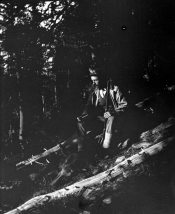Thanks to all for the welcome!
I considered sending digital scans off to be printed, but with the nature of the project, I'm hoping that I can come across an enlarger and make the printing part of the museum project. That would be quite a "local" touch.
The "old-timer" helping with the project is a local artist, and I can see the museum making a darkroom part of a learning experience, even working with other area projects.
As I go through the negatives, I see evidence that the museum building, where this project was managed starting in 1916, may have included a darkroom. There is a small room that looks like it may have been used to develop the films.
The films are well documented, as to photographer, date, location, subject - even the settings on the cameras. With the negatives are quite a few contact prints, mounted by corner slits onto a heavy cardstock paper. Those prints offer even more details. The negs were stored in specially made file cabinets made to fit the manila envelopes, sized to fit the negs.
In the earlier project, the negs were shot by an early resident in a town along the Rocky Mountain Front. Many of those were shot on 5X7, too. Was that a popular film format in the early 1900s?
I did notice an Elwood 5X7 on Ebay, but it was more or less a collection of parts. At least having a brand name gives me more options to search.







